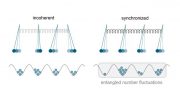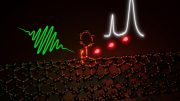
Research shows why fireflies blink in unison even though each individual insect is different. Credit: Toan Phan
Northwestern University researchers have added a new dimension to the importance of diversity.
For the first time, physicists have experimentally demonstrated that certain systems with interacting entities can synchronize only if the entities within the system are different from one another.
This finding offers a new twist to the previous understanding of how collective behavior found in nature — such as fireflies flashing in unison or pacemaker cells working together to generate a heartbeat — can arise even when the individual insects or cells are different.
Northwestern’s Adilson Motter, who led the research, explained that identical entities naturally behave identically — until they start interacting.
“When identical entities interact, they often behave differently from each other,” said Motter, who is a professor of physics in Northwestern’s Weinberg College of Arts and Sciences. “But we identified scenarios in which the entities behave identically again if you make them subtly different from each other.”
“This discovery is remarkable mathematically, let alone physically.” — Takashi Nishikawa
This discovery could help researchers optimize human-made systems, such as the power grid, in which many parts have to remain synchronized while interacting with one another. It also could potentially inform how groups of humans, such as juries, can coordinate to reach a consensus.
The research was published today (Jan. 20) in the journal Nature Physics. Motter coauthored the paper with Northwestern’s Takashi Nishikawa and Ferenc Molnar, a former postdoctoral researcher at Northwestern who is now at Notre Dame University.
This work expands upon Nishikawa’s and Motter’s 2016 paper, which theoretically predicted the phenomenon.
“It is interesting that systems need to be asymmetric to exhibit behavioral symmetry,” said Nishikawa, a research professor of physics in Weinberg. “This is remarkable mathematically, let alone physically. So, many colleagues thought that experimentally demonstrating this effect was impossible.”

Research shows how geese can coordinate to all move together in a flock or V formation even though each individual bird is different. Credit: Wendy Wei
Motter and his collaborators made the seemingly impossible possible by using three identical electric generators. Each generator oscillated at a frequency of exactly 100 cycles per second. When separated, the identical generators behaved identically.
When connected to form a triangle, their frequencies diverged — but only until the generators were properly mismatched to have different energy dissipations. At that point, they synchronized again.
“This can be visualized by putting a small lamp between each pair of generators,” Molnar explained. “When the generators are identical, the lamp flickers, meaning that the generators are not synchronized. But when the generators’ dissipation is tweaked to different levels, the flickering stop, indicating that the generator voltages are oscillating in sync.”
The researchers dubbed this phenomenon “converse symmetry breaking” because it represents the opposite of the previously known phenomenon of symmetry breaking, which underlies superconductivity, the Higgs mechanism and even the appearance of zebra stripes.
In symmetry breaking, the dynamical equations have a symmetry that is not observed in the behavior of the system, while converse symmetry breaking concerns situations in which the behavior of the system has a given symmetry only when that symmetry is avoided in the dynamical equations.
“It might seem counterintuitive,” Motter said. “But our theory predicts that this is true across many systems, not just electromechanical ones.”
Motter’s team plans to explore the implications of their findings across social, technological and biological systems. In particular, the team is actively working on the design of a power grid that is more stable while allowing incorporation of an increasing share of energy from renewable sources.
The study, “Network experiment demonstrates converse symmetry breaking,” was supported by Northwestern University’s Finite Earth Initiative and the Army Research Office (grant number W911NF-15-1-0272). Motter also is a member of the Northwestern Institute on Complex Systems.









Thank you for published
Thank you for posting this. I remain in constant awe of the synchronization of complex biological systems. We call this “Entrainment” casually, and in neuroscience we can easily measure the coupling that occurs on EEG, e.g., how brainwaves synchronize with oscillations in external stimuli like sound (rhythmic music) or visuals (flashing lights). However, we don’t really UNDERSTAND why the phenomenon occurs on such a large scale throughout human functions. Humans synchronize everything from brainwaves to auto-motor alignment (like, a foot tapping to music) to gait (when walking in a group) to circadian & hormonal cycles. Virtually every cyclical aspect of human function & behavior is subject to synchronization.
It is both awe-inspiring & scary to think about this. When we finally are able to manipulate the biological tendency towards synchronization using synthetic means, we will likely achieve tremendous gains in medicine. For example, we’ll be able to repair the motor system in humans with gait/ walking dysfunction. We’ll likely be able to correct the brain fog associated with depression & other negative mental states. Unfortunately, this can be exploited, too. Brainwave entrainment may have troubling applications in casinos & all types of gaming & gambling.